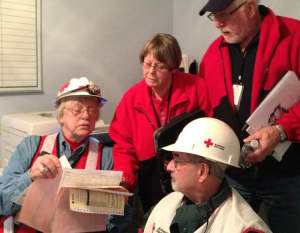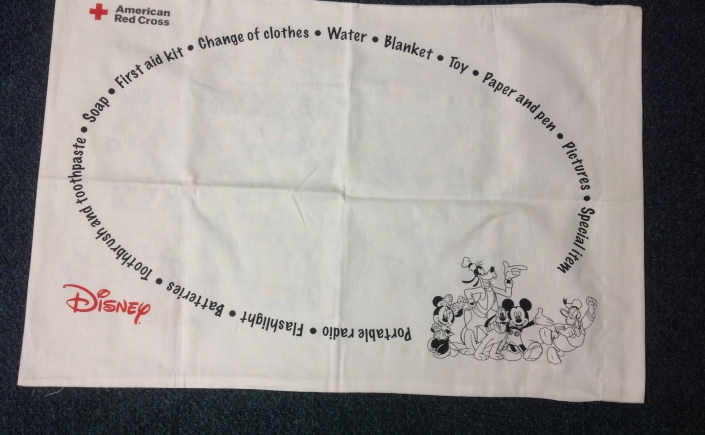Day In the Life Of a DAT Responder



By Brian DeLoche
For the American Red Cross
Peace and quiet. It’s what draws people to the rural countryside of west-central Illinois.
Where Greg and Darla Hobson live just off County Highway 21, outside the tiny hamlet of Valley City, that peace and quiet is usually disturbed only by the sound of an occasional passing car or truck, or depending on the time of year, the sound of tractors or combines in the nearby fields.
But on a warm Saturday afternoon (Dec. 1 no less), Darla heard an unusual sound outside her home. “It was a sound like I’d never heard before,” she said. “So, I opened the front door to see what was going on.”
That’s when her world was turned upside down. “As soon as I opened the door, I was picked up and blown across the room,” she said. “I grabbed onto a chair (an oversized living room chair) and for a while that chair and I were dancing in the air.”
“For a minute there, I thought she was going to be blown away,” Greg, who was seated in the living room putting on his shoes when the storm hit.
Their home, along with those of their sons on either side of their property had just been hit by one of the more than 20 tornadoes reported as a storm system ripped its way across Illinois in the mid-afternoon hours of Dec. 1.
For the Hobsons, there was no advanced warning. In the remote rural countryside, there are no warning sirens. “We knew there was supposed to be a chance of severe storms in the area that day. But we didn’t get any warning about a tornado,” Darla said.
“We were just getting ready to head into town (Griggsville) for our granddaughter’s birthday party. Our son Cody and his wife live right next door and they had already left. They called and said they had forgotten the ice cream for the party and asked us to stop in and pick it up for them. We were on the way to get it when the storm hit.”
As fate would have it, they never made it to their son’s house next door, and they didn’t make it to the party. The storm destroyed their son’s mobile home that stood less than 100 yards from their front door. “If we’d gotten out the door two minutes earlier, we would have been inside their house when the storm hit.”
The winds that destroyed her son’s house also did major damage to her own small, cozy home on the hill. The winds that tossed Darla across the room, blew the north wall out of her kitchen. “I still have no idea where my pots and pans are,” she said. The small microwave oven that sat in a built-in cabinet was ripped from its space and thrown into a field between her home and her son Brandon’s house. “Believe it or not, it still works,” she added as she pointed to the stainless steel appliance now back in its place.
“I can’t tell you much about what happened after that,” Mrs. Hobson said. “The next few hours were kind of a blur. But I remember somebody told me the Red Cross would be coming to help us out. I can’t tell you how long it was before they got here, but it was the same evening after the storm hit.”
“I can’t tell you their names, but they were so good to us,” she said. “They stopped at a grocery store in Barry, Il before they came here and they brought us groceries.”
“They stayed and talked with us for quite a while,” Darla said, “and that helped us calm down a bit.” All three Hobson families received Red Cross Direct Client Assistance.
Darla said she was amazed by the outpouring of support friends and neighbors have shown her family since the disaster. “It’s good to have friends, and have children who have friends,” she said with a smile, while dozens of people, many of whom brought machinery to help clean up the debris, worked on all three properties.
Darla said she will most likely use a portion of the immediate assistance funds she received from the Red Cross to buy a new vacuum cleaner. “There’s dirt and dust everywhere, in places like the inside of my kitchen cabinets. I don’t know if I’ll ever get done cleaning,” she said with a laugh.
Even though her home suffered major damage, the Hobsons still found time to laugh at the unusual things that managed to survive. A four foot tall Santa Claus figure made mostly of plastic and cloth stood at the front door of their home. The figure was tied to a post on the south side of the porch with only a couple pieces of yarn to hold it in place. After the storm, the statue was moved about 4-6 feet, and down a couple of steps and left still standing on the opposite side of the porch. Icicle lights and other Christmas decorations remained on the porch seemingly undamaged.
At her son Cody’s home, the storm destroyed the house, but left standing a plastic nutcracker statue held in place with screws on a porch railing. “It blew up my house, but somehow, the plastic nutcracker survived,” Cody said.
Though there have been a lot of tears so far, and more likely to come, Darla said, she will continue to look for a laugh wherever she can find it.
“You can’t let it get your sense of humor,” she said with a smile, “cause sometimes it’s all you’ve got.”

As storms swept through Illinois, Saturday, December 1, 2018, American Red Cross Central and Southern Illinois Region leadership and volunteers strategized how to best help those affected and yet to be impacted by what turned into more than two dozen tornadoes.
The decision to open a shelter starts long before it’s needed. One obvious decision making factor is need. Are there a significant number of people who need a safe place to stay? That number varies depending on family size, for instance.
The Red Cross has more than 2000 pre-identified shelters in Illinois. But, how do we choose the appropriate location during a disaster?
Let’s say there are five pre-identified potential shelters in a county disaster area. The number of people who need a safe place to stay is definitely a primary consideration.
Beyond that, criteria includes choosing a facility that’s ADA-accessible so it is friendly to all.
Another factor in our decision is where is the facility? We look for place that are close to the disaster yet outside of the perimeter of the disaster area, at the same time. It’s a thoughtful decision-making process to make sure we are helping people in a given area in the best way we can help them at a time they need care and consideration for their basic needs.
A nurse is present or on-call for our shelters 24 hours a day to monitor health needs of clients and staff.
In the case of the December 2018 severe storms in Taylorville, Illinois, this safe center pictured above is in the hardest hit community that sustained most significant damage.
If possible, we ask shelter residents to bring any medications and medical equipment needed by any family members for their overnight stays.
One noteworthy final fact: public schools, community colleges, public universities and civic centers are required by law to work with the Red Cross in providing shelter should the need present itself. Our pre-identified sheltering agreements include those types of facilities, as well as places of worship such as hundreds of churches and temples.
Shelter location in photo: Crossroads Apostolic Christian Church, 212 Jaycee Drive, Taylorville, IL

I believe that this is true…
So when I saw the following on redcross.org, I wanted to share it with you.
Every night in America, while most of us are sleeping, American Red Cross disaster volunteers are standing on the lawn of someone who has just lost their home and everything they own in a fire. Our volunteers give them a warm blanket, a hot cup of coffee, a place to stay for the night and a plan to help them get back on their feet.
A Night in the Life of Our Disaster Volunteers
The Red Cross responds to help a family affected by a home fire every 8 minutes. Follow the typical journey of our disaster volunteers as they respond to a home fire:
1:10 a.m. A Red Cross disaster volunteer receives a call from the local Fire Department that there has been a home fire in their community. She quickly gets up, gets dressed and calls another volunteer to meet her at the location of the home fire. Continue reading

Whether it is a blood drive, large wildfire, preparedness information or the Ebola outbreak, #RedCross across the country has been blowing up Twitter-sphere this week! Here are a few of my favs that you may have missed.

This timeline from a very talented volunteer shows the Red Cross disaster timeline perfectly. His subject matter? The November 17th tornadoes that devastated parts of Illinois.

1. They love when they get a call that wakes them up in the middle of the night.

These Kansas City volunteers, including one of my favorite guys, Carl, are helping after an apartment complex fire.
2. Being “chained to a desk” is one of their favorite parts of the week. Continue reading

Last year, we…

What I am about to write about isn’t your typical dirty laundry! (And to be honest, it isn’t really dirty.) The laundry I am talking about is really a pillowcase, and it’s clean. This pillowcase doesn’t have a typical life. It’s one goal is to help children learn about local hazards and preparedness.
Now, you must be thinking “Is this woman delusional? Talking about laundry and preparedness? How does this even relate to each other??” In this case, the Pillowcase Project teaches students how to stay safe and calm during an emergency, and how to be prepared for when emergencies happen. It is designed for 3rd through 5th graders, and is a National Red Cross pilot program. Our Region was awarded a grant to present this program to our local youth and, to be honest, it’s very timely considering some of our recent weather. Continue reading

We spent the whole weekend house hunting, and, man, is that exhausting. I have lived here my entire life yet I think I have seen more of central Illinois in the last 48 hours than ever before. There were many homes that we didn’t get to see, though, because of flooded roads. I was so happy when the snow was finally melting, but it melted a little too fast for the frozen ground. We encountered a lot of flooded roadways, and being the good Red Crosser that I am, we did not attempt to drive through.
After driving over 150 miles in a Sunday afternoon, we were finally home. My overworked and almost dead phone was very happy to be on the charger after a day of home searching and Google mapping. And, I was elated to settle in for the season finale of Downton Abbey. Before bed, I saw that I missed a call from my good friend and our local Preparedness Health & Safety Training Specialist, Traci Johnston. Since it was late, I just texted to see what she needed. This morning, I received this response, “I will be late this morning. We totaled my car but we are okay. It is a crazy story. I have to get a rental and then we will be in”.
When Traci finally made it to work, she was greeted with a wild-eyed Erin. I was so worried about what happened and wanted to hear the story. This is what she told me…
You must be logged in to post a comment.